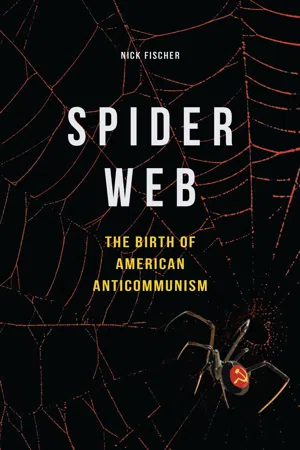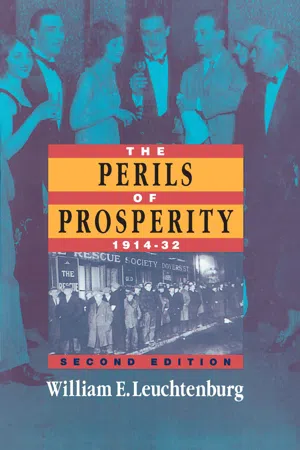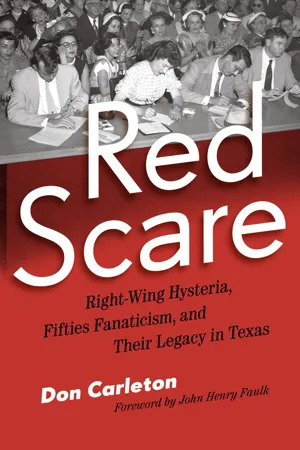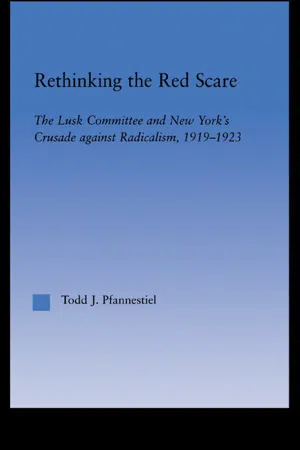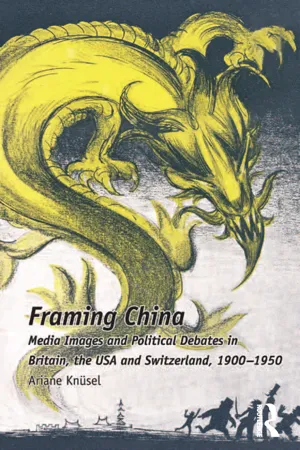History
First Red Scare
The First Red Scare was a period of intense anti-communist hysteria in the United States following World War I. It was characterized by fear of communist infiltration and led to widespread government crackdowns on suspected radicals, as well as public hysteria and discrimination against immigrants and political dissidents. The Red Scare was fueled by events such as the Russian Revolution and labor strikes, and it had a lasting impact on American society and politics.
Written by Perlego with AI-assistance
Related key terms
Related key terms
1 of 4
Related key terms
1 of 3
7 Key excerpts on "First Red Scare"
- eBook - ePub
Spider Web
The Birth of American Anticommunism
- Nick Fischer(Author)
- 2016(Publication Date)
- University of Illinois Press(Publisher)
CHAPTER 2
The First World War and the Origins of the Red Scare
Don't you know that some man with eloquent tongue could put this whole country into a flame?…What an opportunity for some man without conscience to spring up and say: “This is the way. Follow me”—and lead in the paths of destruction!—Woodrow WilsonW hile anticommunism had been an important element of American politics since the 1870s, the US entry into the First World War in April 1917, contributed greatly to the next phase of its development, the Red Scare of 1919–20. The effort required to bring a reluctant nation into the war and quash dissenting voices brought the federal government into the business of systematic rather than ad hoc industrial and political repression. The civil liberties of citizens who protested either the commitment to war or its effects were suppressed. Cultural conformity was asserted with unprecedented force and consistency. The place of nativism and antiradicalism in American politics and society became elevated. The compact between the federal government and American citizens was mediated by ideologies of political conformism and industrial quiescence and enforced by federal and public-private bureaucracies and agencies. And the experience of war strengthened capital and weakened workers’ and farmers’ movements. It also set political precedents that helped to spawn a new movement devoted to promoting the cause of anticommunism in American life.US participation in the war made possible the emergence of “modern” anticommunism in several ways. First, it expanded the use of draconian and quasi-legal methods of suppressing strikes and other activity that threatened industrial output. For example, the deployment of the US Army to put down industrial disturbances, which had not occurred since the Pullman strike, became standard practice. Second, it exacerbated social and political conformism by intensifying the association of nonconformists with treachery and subversion. This atmosphere of conformity and the widespread persecution of perceived rebels and dissidents soon carried over into the Red Scare and did much to establish the cultural censorship and repression associated with Cold War anticommunism. The war effort also provided political cover for big business to broaden its assault on labor organizations, beginning with the Industrial Workers of the World (IWW) and then continuing with conservative craft unions. Business further used the war crisis to destroy numerous cooperative associations, just as it had previously destroyed the Knights of Labor. Republican and Democratic leaders used the war to pit the state against rival and smaller political parties. The outright destruction or neutering of organizations such as the Nonpartisan League and the Working Class Union was reminiscent of the treatment meted out to Civil War draft resisters and paved the way for subsequent assaults on the Union of Russian Workers, the Socialist Party of the United States, and the Communist and Communist Labor Parties. - eBook - ePub
The Cold War at Home
The Red Scare in Pennsylvania, 1945-1960
- Philip Jenkins(Author)
- 2014(Publication Date)
- The University of North Carolina Press(Publisher)
4Red Scare Rampant, 1950–1953
We are a nation at war.... The force that is killing our loved ones, the power that is fighting against our democracy, is Communist, Godless Russia. It is fantastic to fight Communism with all our strength abroad, and to ignore it here at home.—State Senator Albert R. Pechan, 19531In retrospect, it seems remarkable that the suppression of a national political movement aroused so little opposition, but the virulence of anti-Communist feeling arose from general fears of a new world war in which American Communists might become an alien fifth column. The new Red Scare had its roots in events of the late 1930s, when the Roosevelt administration had exaggerated the threat of domestic traitors in order to make Americans more willing to confront the Axis powers, portraying native Fascist sympathizers as the allies of foreign intelligence services. Between 1938 and 1942, popular media often reported on the likely dangers of espionage and sabotage, and some genuine incidents of both did occur. In their struggles against Fascism and militarism, Americans were subjected to constant propaganda about the absolute evil of the Nazi and Japanese regimes, charges that had been confirmed by the exposure of the atrocities committed by those totalitarian states.2 The hatred stirred in the early 1940s was soon redirected against international Communism—Red Fascism—a menace made still more threatening by its capacity to devastate the American homeland with nuclear weapons.3This international context is essential to understanding the escalation of the Red Scare into a perceived threat of clandestine warfare on American soil. An official campaign to uncover potential enemy sympathizers did much to shape public attitudes to domestic Communism, and the anti-Communist movement was repeatedly galvanized by the events of this underground war. The appearance of FBI - eBook - ePub
- William E. Leuchtenburg(Author)
- 2010(Publication Date)
- University of Chicago Press(Publisher)
4Red Scare
In the year 1919, Senator McKellar of Tennessee advocated sending native-born American citizens with radical beliefs to a penal colony in Guam. South Carolina’s James F. Byrnes asked for the intervention of the federal government to balk an uprising of Negroes that he declared Reds were planning in the South. Some New York schoolteachers were dismissed after a campaign to determine “Who’s Red and Who’s True Blue.” General Leonard Wood, the Army Chief of Staff, noted his approval of a minister’s call for the deportation of Bolshevists “in ships of stone with sails of lead, with the wrath of God for a breeze and with hell for their first port.” “If I had my way with these ornery wild-eyed Socialists and I. W. W.’s,” shouted the evangelist Billy Sunday, “I would stand them up before a firing squad and save space on our ships.” In Indiana a jury deliberated two minutes before acquitting Frank Petroni, who had shot and killed a man for yelling, “To hell with the United States!” The great Red Scare of 1919 was underway.Although there had been concern about radicalism, particularly anarchism, before the war, and although radicals had been censured during the war as pro-German, the Red Scare did not really begin until the creation of the Communists’ Third International in March, 1919. The Bolshevik Revolution of November, 1917, had awakened fears, but it was less the revolution itself than the spread of revolutionary principles to other countries that excited alarm. In March, 1919, Communist uprisings in Bavaria and Hungary aroused anxiety that bolshevism might engulf the Western world. Few doubted that a revolution in the United States had a high place on the Communists’ agenda. Karl Radek, the executive secretary of the Third International, boasted that money sent to Germany for the Spartacist uprising “was as nothing compared to the funds transmitted to New York for the purpose of spreading bolshevism in the United States.” - eBook - ePub
Red Scare
Right-Wing Hysteria, Fifties Fanaticism, and Their Legacy in Texas
- Don Carleton(Author)
- 2014(Publication Date)
- University of Texas Press(Publisher)
FIVE THE RED SCARE BEGINSMen who fear witches soon find themselves surrounded by them .—Kai EricksonThose were the days when the Communist obsession was like Montezuma’s Revenge to a tourist in Mexico. Everybody was on the run .—Methodist bishop W. Kenneth Pope 1The Red Scare in Houston, just as with the nation as a whole, has no specific beginning date. There is no single event that in hindsight can be said to have announced the start of an era. This is because a “Red Scare” has been simmering just beneath the thin skin of American tolerance since the Bolsheviks seized power in Russia in 1917. After the First Red Scare following World War I, however, it took the Cold War to bring extreme anti-Communism back out into the open as a defining characteristic of American society.As noted in a previous chapter, Houston’s conservative power elite escalated its extreme anti-Communist rhetoric in the late 1940s. By that time some Houstonians were beginning to perceive that the use of Red Scare tactics might be the easiest way to ensure success in contests over public issues. The controversy over zoning in 1947 is an example of this new awareness. In previous years when the question of land use zoning became a subject of public debate, Houston’s antizoning faction had emphasized that governmental regulation of land development was functionally unworkable and prone to corruption. Even in 1947 a “Report to the Mayor by the Committee against Zoning” stressed that zoning would slow urban growth and that automobiles and freeways would eventually decentralize the business district, making functional segregation unnecessary. As one student of this movement has noted, the antizoning faction developed an “intelligent and rational critique” of zoning’s shortcomings. In presenting the issue to the public, however, antizoners avoided this rational argument. Rather than attempting to explain a somewhat complicated position, the antizoners took advantage of the growing Red Scare and simply portrayed zoning as a “threat to the American Way of Life.” Advertisements, for example, argued that under zoning physicians and dentists could not have home offices and that this was the “first step toward socialized medicine.” An ironical aspect of this debate was that the antizoners, consisting mainly of small businessmen and real estate speculators, opposed the 8-F Crowd led by Jesse Jones. The Red Scare environment that Jones and the power elite had so actively cultivated was turned against them in this case. The city was entertained by the spectacle of Hugh Roy Cullen calling Jesse Jones’ zoning plan “un-American.” Houstonians soundly defeated the zoning proposal in an election on January 31, 1948, with 68 percent voting against and only 31 percent voting for land use planning.2 - eBook - ePub
Rethinking the Red Scare
The Lusk Committee and New York's Crusade Against Radicalism, 1919-1923
- Todd J. Pfannestiel(Author)
- 2004(Publication Date)
- Routledge(Publisher)
26Nonetheless, these “parlor Bolsheviks” seemed dangerous to the general public, which overestimated the size and influence of the threat as they blamed most of the country’s ills on Bolshevism. Traveling through the U.S. at the time, a British journalist captured the essence of the emerging national hysteria when he observed “No one will forget the feverish condition of the public mind; it was hag-ridden by the spectre of Bolshevism.” Comparing the condition to a nightmare, he recalled the words of one person who feared the conformity that repression forced upon the nation. “‘America,’ as one I was with at the time said, ‘is the land of liberty—liberty to keep in step.’”27The difficult months of transition from war to peace and the presence of a concerted radical movement in the country set the stage for the hysteria that became the Red Scare; all that remained was for a catalyst to link the two and provide the spark. The popular press and public officials were more than willing to oblige. As early as December, 1918, the Hartford Courant declared that the red flag, symbolic of a political system antagonistic to Americanism, had been raised from coast to coast. At the same time, the Wall Street Journal commended New York City’s Mayor John Hylan for outlawing public displays of any red flag within the city. Furthermore, Boston’s Christian Science Monitor maintained that serious investigation into Bolshevik activities in the United States should occur.28Events at the end of the year appeared to corroborate such concern. On the final day of December, 1918, when a series of bomb explosions in Philadelphia wrecked the homes of three Pennsylvania government officials, a police inspector declared it was part of a nationwide Bolshevik plot. The police immediately seized a leader of the Revolutionary Labor Party because of his past demonstrations and activities. Although the authorities released him three days later for lack of evidence, Captain J.C.Mills of the Philadelphia police department nevertheless warned that outbreaks could be expected at any time in any part of the nation. Taking Mills’ warning to heart, New York City police stationed special guards at the City Hall and Court House, increased the number of regular patrolmen on duty, and gave detectives special assignments to watch every suspected anarchist.29 - eBook - ePub
Popular Perceptions of Soviet Politics in the 1920s
Disenchantment of the Dreamers
- O. Velikanova(Author)
- 2013(Publication Date)
- Palgrave Macmillan(Publisher)
The experience of total war with the mobilization of all national resources led to a shift of balance between the civil and military sectors of national economies in favour of a higher level of militarization. The comprehensive mobilization of people for war, while limiting their political participation, was a common feature of all the major belligerents. 9 The USSR contributed to these international tensions with its vacillating foreign policy and, most of all, through Comintern activities that aimed to destabilize ‘imperialism’. Mistrust and military or conspiratorial scares were regular occurrences in a world divided into two camps. In 1919–20, a ‘Red Scare’ of imminent communist revolution spread in the United States, resulting in the arrest of 6000 suspected socialists and anarchists. The subversive activities of the Comintern caused a similar red scare in Great Britain in October 1924, contributing to the downfall of the Labour Government and increasing tensions in Anglo-Soviet relations. A more artificial war scare followed the statement of US Secretary of State, F. B. Kellogg, on January 24, 1927, that Bolshevik agents stood behind the Liberal revolution in Nicaragua. This short-term international crisis 10 coincided with the beginning of a war scare in the USSR. The alarmist statements of politicians found willing ears in the population during moments of instability and crisis. In a world polarized by antagonistic ideologies, governments and people watched every moment for hostile agents and real, or imagined, enemies. In the USSR, the proclivity to see the threat of war was founded on the traumatic experiences of the 1914–22 period. The memory of 1918–20, when internal peasants’ revolts and Civil War were combined with foreign intervention, still haunted the Bolsheviks in the 1920s. It became a formative experience for the generation of revolution. R - eBook - ePub
Framing China
Media Images and Political Debates in Britain, the USA and Switzerland, 1900-1950
- Ariane Knüsel(Author)
- 2016(Publication Date)
- Routledge(Publisher)
Several strikes in autumn 1919 including a police strike in Boston and strikes in the steel and coal industries strengthened the belief that revolutionaries had infiltrated the labour movement and were planning to overthrow the American government. Attorney General A. Mitchell Palmer, at whose house one of the bombs had exploded, started the so-called Palmer Raids, a crusade in which he persecuted radicals with the help of J. Edgar Hoover, head of the General Intelligence Division of the Justice Department. The Palmer Raids began on 7 November 1919, mostly targeting the Union of Russian Workers but also other radicals, especially anarchists. At least 246 of these radicals were deported to Russia in December on the Buford, also known as the Soviet Ark. The Red Scare reached its peak during the second group of raids which took place between 2 and 5 January 1920, when over 6,000 suspected radicals, among them many members of the Communist Parties, were arrested all over the USA. In May 1920, a federal judge ruled that membership in one of the Communist Parties alone was not reason enough for deportation. The public mood also changed after it became known that many law-abiding citizens had been arrested, detained, mistreated and occasionally even died in custody. This together with an absence of big strikes and bombings before September 1920 turned public opinion against red-hunting. 83 The Red Scare affected American public opinion to such a degree that communism remained an enemy image throughout the 1920s and not only proved very effective against radicalism in the USA but also practically destroyed the American Left and massively reduced the labour movement’s militancy. Both Communist Parties had lost the majority of their members and were forced to go underground, the Socialist Party was weakened, the IWW was almost completely destroyed and the American Federation of Labor had become a staunch antiradical organization
Index pages curate the most relevant extracts from our library of academic textbooks. They’ve been created using an in-house natural language model (NLM), each adding context and meaning to key research topics.
Explore more topic indexes
Explore more topic indexes
1 of 6
Explore more topic indexes
1 of 4
